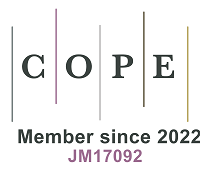REFERENCES
1. Alaee M, Arias P, Sjödin A, Bergman A. An overview of commercially used brominated flame retardants, their applications, their use patterns in different countries/regions and possible modes of release. Environ Int 2003;29:683-9.
3. UNEP. Report of the Conference of the Parties of the Stockholm Convention on Persistent Organic Pollutants on the work of its fourth meeting. 2009. Available from: http://chm.pops.int/portals/0/repository/cop4/unep-pops-cop.4-38.english.pdf [Last accessed on 21 Feb 2024].
4. UNEP. Report of the Conference of the Parties of the Stockholm Convention on Persistent Organic Pollutants on the work of its ninth meeting. 2017. Available from: https://chm.pops.int/TheConvention/ConferenceoftheParties/Meetings/COP9/tabid/7521/Default.aspx [Last accessed on 21 Feb 2024].
5. Covaci A, Gerecke AC, Law RJ, et al. Hexabromocyclododecanes (HBCDs) in the environment and humans: a review. Environ Sci Technol 2006;40:3679-88.
6. UNEP. The new POPs under the Stockholm Convention. 2023. Available from: https://chm.pops.int/TheConvention/ThePOPs/TheNewPOPs/tabid/2511/Default.aspx [Last accessed on 21 Feb 2024].
7. Law RJ, Allchin CR, de Boer J, et al. Levels and trends of brominated flame retardants in the European environment. Chemosphere 2006;64:187-208.
8. Abbasi G, Li L, Breivik K. Global historical stocks and emissions of PBDEs. Environ Sci Technol 2019;53:6330-40.
9. Akortia E, Okonkwo JO, Lupankwa M, et al. A review of sources, levels, and toxicity of polybrominated diphenyl ethers (PBDEs) and their transformation and transport in various environmental compartments. Environ Rev 2016;24:253-73.
10. Zhu L, Hajeb P, Fauser P, Vorkamp K. Endocrine disrupting chemicals in indoor dust: a review of temporal and spatial trends, and human exposure. Sci Total Environ 2023;874:162374.
11. Zhu L, Fauser P, Mikkelsen L, Sanderson H, Vorkamp K. Suspect and non-target screening of semi-volatile emerging contaminants in indoor dust from Danish kindergartens. Chemosphere 2023;345:140451.
12. Vorkamp K, Balmer J, Hung H, Letcher RJ, Rigét FF, de Wit CA. Current-use halogenated and organophosphorous flame retardants: a review of their presence in Arctic ecosystems. Emerg Contam 2019;5:179-200.
13. Zuiderveen EAR, Slootweg JC, de Boer J. Novel brominated flame retardants - a review of their occurrence in indoor air, dust, consumer goods and food. Chemosphere 2020;255:126816.
14. Sjödin A, Patterson DG Jr, Bergman A. A review on human exposure to brominated flame retardants - particularly polybrominated diphenyl ethers. Environ Int 2003;29:829-39.
15. Frederiksen M, Thomsen M, Vorkamp K, Knudsen LE. Patterns and concentration levels of polybrominated diphenyl ethers (PBDEs) in placental tissue of women in Denmark. Chemosphere 2009;76:1464-9.
16. Frederiksen M, Vorkamp K, Thomsen M, Knudsen LE. Human internal and external exposure to PBDEs - a review of levels and sources. Int J Hyg Environ Health 2009;212:109-34.
17. Govarts E, Gilles L, Rodriguez Martin L, et al. Harmonized human biomonitoring in European children, teenagers and adults: EU-wide exposure data of 11 chemical substance groups from the HBM4EU Aligned Studies (2014-2021). Int J Hyg Environ Health 2023;249:114119.
18. van der Schyff V, Kalina J, Govarts E, et al. Exposure to flame retardants in European children - results from the HBM4EU aligned studies. Int J Hyg Environ Health 2023;247:114070.
19. Cooper EM, Kroeger G, Davis K, Clark CR, Ferguson PL, Stapleton HM. Results from screening polyurethane foam based consumer products for flame retardant chemicals: assessing impacts on the change in the furniture flammability standards. Environ Sci Technol 2016;50:10653-60.
20. Hoffman K, Fang M, Horman B, et al. Urinary tetrabromobenzoic acid (TBBA) as a biomarker of exposure to the flame retardant mixture Firemaster® 550. Environ Health Persp 2014;122:963-9.
21. Butt CM, Congleton J, Hoffman K, Fang M, Stapleton HM. Metabolites of organophosphate flame retardants and 2-ethylhexyl tetrabromobenzoate in urine from paired mothers and toddlers. Environ Sci Technol 2014;48:10432-8.
22. Stapleton HM, Allen JG, Kelly SM, et al. Alternate and new brominated flame retardants detected in U.S. house dust. Environ Sci Technol 2008;42:6910-6.
23. Tao F, Abou-Elwafa Abdallah M, Ashworth DC, Douglas P, Toledano MB, Harrad S. Emerging and legacy flame retardants in UK human milk and food suggest slow response to restrictions on use of PBDEs and HBCDD. Environ Int 2017;105:95-104.
24. Shi Z, Zhang L, Li J, et al. Novel brominated flame retardants in food composites and human milk from the Chinese total diet study in 2011: concentrations and a dietary exposure assessment. Environ Int 2016;96:82-90.
25. Chen T, Huang M, Li J, Li J, Shi Z. Polybrominated diphenyl ethers and novel brominated flame retardants in human milk from the general population in Beijing, China: Occurrence, temporal trends, nursing infants' exposure and risk assessment. Sci Total Environ 2019;689:278-86.
26. Schreder E, Zheng G, Sathyanarayana S, Gunaje N, Hu M, Salamova A. Brominated flame retardants in breast milk from the United States: first detection of bromophenols in U.S. breast milk. Environ Pollut 2023;334:122028.
27. Zhou T, Taylor MM, DeVito MJ, Crofton KM. Developmental exposure to brominated diphenyl ethers results in thyroid hormone disruption. Toxicol Sci 2002;66:105-16.
28. Herbstman JB, Sjödin A, Kurzon M, et al. Prenatal exposure to PBDEs and neurodevelopment. Environ Health Persp 2010;118:712-9.
29. Costa LG, Giordano G. Developmental neurotoxicity of polybrominated diphenyl ether (PBDE) flame retardants. Neurotoxicology 2007;28:1047-67.
30. Kim YR, Harden FA, Toms LM, Norman RE. Health consequences of exposure to brominated flame retardants: a systematic review. Chemosphere 2014;106:1-19.
31. Eskenazi B, Chevrier J, Rauch SA, et al. In utero and childhood polybrominated diphenyl ether (PBDE) exposures and neurodevelopment in the CHAMACOS study. Environ Health Persp 2013;121:257-62.
32. Vuong AM, Yolton K, Cecil KM, Braun JM, Lanphear BP, Chen A. Flame retardants and neurodevelopment: an updated review of epidemiological literature. Curr Epidemiol Rep 2020;7:220-36.
33. Dong L, Wang S, Qu J, You H, Liu D. New understanding of novel brominated flame retardants (NBFRs): neuro(endocrine) toxicity. Ecotox Environ Safe 2021;208:111570.
34. Belcher SM, Cookman CJ, Patisaul HB, Stapleton HM. In vitro assessment of human nuclear hormone receptor activity and cytotoxicity of the flame retardant mixture FM 550 and its triarylphosphate and brominated components. Toxicol Lett 2014;228:93-102.
35. Patisaul HB, Roberts SC, Mabrey N, et al. Accumulation and endocrine disrupting effects of the flame retardant mixture Firemaster® 550 in rats: an exploratory assessment. J Biochem Mol Toxicol 2013;27:124-36.
36. Pillai HK, Fang M, Beglov D, et al. Ligand binding and activation of PPARγ by Firemaster® 550: effects on adipogenesis and osteogenesis in vitro. Environ Health Persp 2014;122:1225-32.
37. Fromme H, Becher G, Hilger B, Völkel W. Brominated flame retardants - exposure and risk assessment for the general population. Int J Hyg Environ Health 2016;219:1-23.
38. Pedersen M, Wichmann J, Autrup H, et al. Increased micronuclei and bulky DNA adducts in cord blood after maternal exposures to traffic-related air pollution. Environ Res 2009;109:1012-20.
39. Samuel TM, Thielecke F, Lavalle L, et al. Mode of neonatal delivery influences the nutrient composition of human milk: results from a multicenter European cohort of lactating women. Front Nutr 2022;9:834394.
40. Rydahl E, Declercq E, Juhl M, Maimburg RD. Cesarean section on a rise - does advanced maternal age explain the increase? A population register-based study. PLoS One 2019;14:e0210655.
41. Vorkamp K, Thomsen M, Frederiksen M, Pedersen M, Knudsen LE. Polybrominated diphenyl ethers (PBDEs) in the indoor environment and associations with prenatal exposure. Environ Int 2011;37:1-10.
42. Frederiksen M, Thomsen C, Frøshaug M, et al. Polybrominated diphenyl ethers in paired samples of maternal and umbilical cord blood plasma and associations with house dust in a Danish cohort. Int J Hyg Environ Health 2010;213:233-42.
43. Frederiksen M, Vorkamp K, Mathiesen L, Mose T, Knudsen LE. Placental transfer of the polybrominated diphenyl ethers BDE-47, BDE-99 and BDE-209 in a human placenta perfusion system: an experimental study. Environ Health 2010;9:32.
44. Vorkamp K, Christensen JH, Glasius M, Riget FF. Persistent halogenated compounds in black guillemots (Cepphus grylle) from Greenland - levels, compound patterns and spatial trends. Mar Pollut Bull 2004;48:111-21.
45. Vorkamp K, Bossi R, Rigét FF, Skov H, Sonne C, Dietz R. Novel brominated flame retardants and dechlorane plus in Greenland air and biota. Environ Pollut 2015;196:284-91.
46. Vorkamp K, Bester K, Rigét FF. Species-specific time trends and enantiomer fractions of hexabromocyclododecane (HBCD) in biota from East Greenland. Environ Sci Technol 2012;46:10549-55.
47. Haug LS, Becher G. Interlaboratory comparison on dioxins in food 2006. Sixth round of an international study. In: Norwegian Institute of Public Health, Oslo, Norway; 2006. Available from https://www.fhi.no/en/publ/2009-and-older/interlaboratory-comparison-on-dioxi-----/ [Last accessed on 22 Feb 2024].
48. Ali N, Harrad S, Muenhor D, Neels H, Covaci A. Analytical characteristics and determination of major novel brominated flame retardants (NBFRs) in indoor dust. Anal Bioanal Chem 2011;400:3073-83.
49. EPA U. Chapter 15- human milk intake. In: Exposure factors handbook 2011 edition (final report). Washington DC: USA. Environmental Protection Agency; 2011. Available from https://www.epa.gov/sites/default/files/2015-09/documents/efh-chapter15.pdf [Last accessed on 22 Feb 2024].
50. EPA U. Update for Chapter 5 of the exposure factors handbook - soil and dust ingestion. In: Exposure factors handbook 2011 edition (final report). Washington, DC: USA. Environmental Protection Agency; 2017. Available from https://www.epa.gov/sites/default/files/2018-01/documents/efh-chapter05_2017.pdf [Last accessed on 22 Feb 2024].
51. USEPA. U.S. EPA. Exposure factors handbook 2011 edition (final report). Environmental Protection Agency, Washington DC, 2011. Available from https://cfpub.epa.gov/ncea/risk/recordisplay.cfm?deid=236252 [Last accessed on 21 Feb 2024].
52. Main KM, Kiviranta H, Virtanen HE, et al. Flame retardants in placenta and breast milk and cryptorchidism in newborn boys. Environ Health Persp 2007;115:1519-26.
53. Antignac JP, Main KM, Virtanen HE, et al. Country-specific chemical signatures of persistent organic pollutants (POPs) in breast milk of French, Danish and Finnish women. Environ Pollut 2016;218:728-38.
54. Geyer HJ, Schramm K-W, Feicht E, et al. Terminal elimination half-lives of the brominated flame retardants TBBPA, HBCD, and lower brominated PBDEs in humans. Organohalogen Compd 2004;66:3820-5. Available from: https://www.osti.gov/etdeweb/biblio/20828431 [Last accessed on 21 Feb 2024].
55. Thomsen C, Stigum H, Frøshaug M, Broadwell SL, Becher G, Eggesbø M. Determinants of brominated flame retardants in breast milk from a large scale Norwegian study. Environ Int 2010;36:68-74.
56. Björklund JA, Sellström U, de Wit CA, Aune M, Lignell S, Darnerud PO. Comparisons of polybrominated diphenyl ether and hexabromocyclododecane concentrations in dust collected with two sampling methods and matched breast milk samples. Indoor Air 2012;22:279-88.
57. Schächtele A, Malisch R, Hardebusch B, et al. WHO- and UNEP-coordinated exposure studies 2000-2019: findings of polybrominated substances (PBDE, HBCDD, PBB 153, PBDD/PBDF). In: Persistent Organic Pollutants in Human Milk. Cham: Springer International Publishing; 2023. pp. 299-342. Available from: https://doi.org/10.1007/978-3-031-34087-1_9 [Last accessed on 22 Feb 2024].
58. Ryan JJ, Rawn DF. The brominated flame retardants, PBDEs and HBCD, in Canadian human milk samples collected from 1992 to 2005; concentrations and trends. Environ Int 2014;70:1-8.
59. Shi Z, Zhang L, Li J, Wu Y. Legacy and emerging brominated flame retardants in China: a review on food and human milk contamination, human dietary exposure and risk assessment. Chemosphere 2018;198:522-36.
60. Eggesbø M, Thomsen C, Jørgensen JV, Becher G, Odland JØ, Longnecker MP. Associations between brominated flame retardants in human milk and thyroid-stimulating hormone (TSH) in neonates. Environ Res 2011;111:737-43.
61. Pratt I, Anderson W, Crowley D, et al. Brominated and fluorinated organic pollutants in the breast milk of first-time Irish mothers: is there a relationship to levels in food? Food Addit Contam Part A 2013;30:1788-98.
62. Abdallah MA, Harrad S. Tetrabromobisphenol-A, hexabromocyclododecane and its degradation products in UK human milk: relationship to external exposure. Environ Int 2011;37:443-8.
63. Harrad S, Abdallah MA. Concentrations of polybrominated diphenyl ethers, hexabromocyclododecanes and tetrabromobisphenol-A in breast milk from United Kingdom women do not decrease over twelve months of lactation. Environ Sci Technol 2015;49:13899-903.
64. Darnerud PO, Lignell S, Aune M, et al. Time trends of polybrominated diphenylether (PBDE) congeners in serum of Swedish mothers and comparisons to breast milk data. Environ Res 2015;138:352-60.
65. Ma Y, Venier M, Hites RA. Tribromophenoxy flame retardants in the Great Lakes atmosphere. Environ Sci Technol 2012;46:13112-7.
66. van der Recke R, Vetter W. Synthesis and characterization of 2,3-dibromopropyl-2,4,6-tribromophenyl ether (DPTE) and structurally related compounds evidenced in seal blubber and brain. Environ Sci Technol 2007;41:1590-5.
67. Möller A, Xie Z, Sturm R, Ebinghaus R. Polybrominated diphenyl ethers (PBDEs) and alternative brominated flame retardants in air and seawater of the European Arctic. Environ Pollut 2011;159:1577-83.
68. Shoeib M, Harner T, Webster GM, Sverko E, Cheng Y. Legacy and current-use flame retardants in house dust from Vancouver, Canada. Environ Pollut 2012;169:175-82.
69. Müller MH, Polder A, Brynildsrud OB, et al. Brominated flame retardants (BFRs) in breast milk and associated health risks to nursing infants in Northern Tanzania. Environ Int 2016;89-90:38-47.
70. Čechová E, Seifertová M, Kukučka P, et al. An effective clean-up technique for GC/EI-HRMS determination of developmental neurotoxicants in human breast milk. Anal Bioanal Chem 2017;409:1311-22.
71. Čechová E, Vojta Š, Kukučka P, et al. Legacy and alternative halogenated flame retardants in human milk in Europe: implications for children's health. Environ Int 2017;108:137-45.
72. Rawn DFK, Quade SC, Corrigan C, et al. Differences in mirex [dechlorane] and dechlorane plus [syn- and anti-] concentrations observed in Canadian human milk. Chemosphere 2023;316:137784.
73. Chi ZH, Goodyer CG, Hales BF, Bayen S. Characterization of different contaminants and current knowledge for defining chemical mixtures in human milk: a review. Environ Int 2023;171:107717.
74. Sahlström LMO, Sellström U, de Wit CA, Lignell S, Darnerud PO. Estimated intakes of brominated flame retardants via diet and dust compared to internal concentrations in a Swedish mother-toddler cohort. Int J Hyg Environ Health 2015;218:422-32.
75. Weijs L, Dirtu AC, Das K, et al. Inter-species differences for polychlorinated biphenyls and polybrominated diphenyl ethers in marine top predators from the Southern North Sea: Part 1. Accumulation patterns in harbour seals and harbour porpoises. Environ Pollut 2009;157:437-44.
76. Wu N, Herrmann T, Paepke O, et al. Human exposure to PBDEs: associations of PBDE body burdens with food consumption and house dust concentrations. Environ Sci Technol 2007;41:1584-9.
77. Coakley JD, Harrad SJ, Goosey E, et al. Concentrations of polybrominated diphenyl ethers in matched samples of indoor dust and breast milk in New Zealand. Environ Int 2013;59:255-61.
78. Toms LM, Hearn L, Kennedy K, et al. Concentrations of polybrominated diphenyl ethers (PBDEs) in matched samples of human milk, dust and indoor air. Environ Int 2009;35:864-9.
79. Jones-Otazo HA, Clarke JP, Diamond ML, et al. Is house dust the missing exposure pathway for PBDEs? An analysis of the urban fate and human exposure to PBDEs. Environ Sci Technol 2005;39:5121-30.
80. der Schyff V, Kalina J, Abballe A, Iamiceli AL, Govarts E, Melymuk L. Has regulatory action reduced human exposure to flame retardants? Environ Sci Technol 2023;57:19106-24.
81. Walters RM, Khanna P, Chu M, Mack MC. Developmental changes in skin barrier and structure during the first 5 years of life. Skin Pharmacol Phys 2016;29:111-8.







